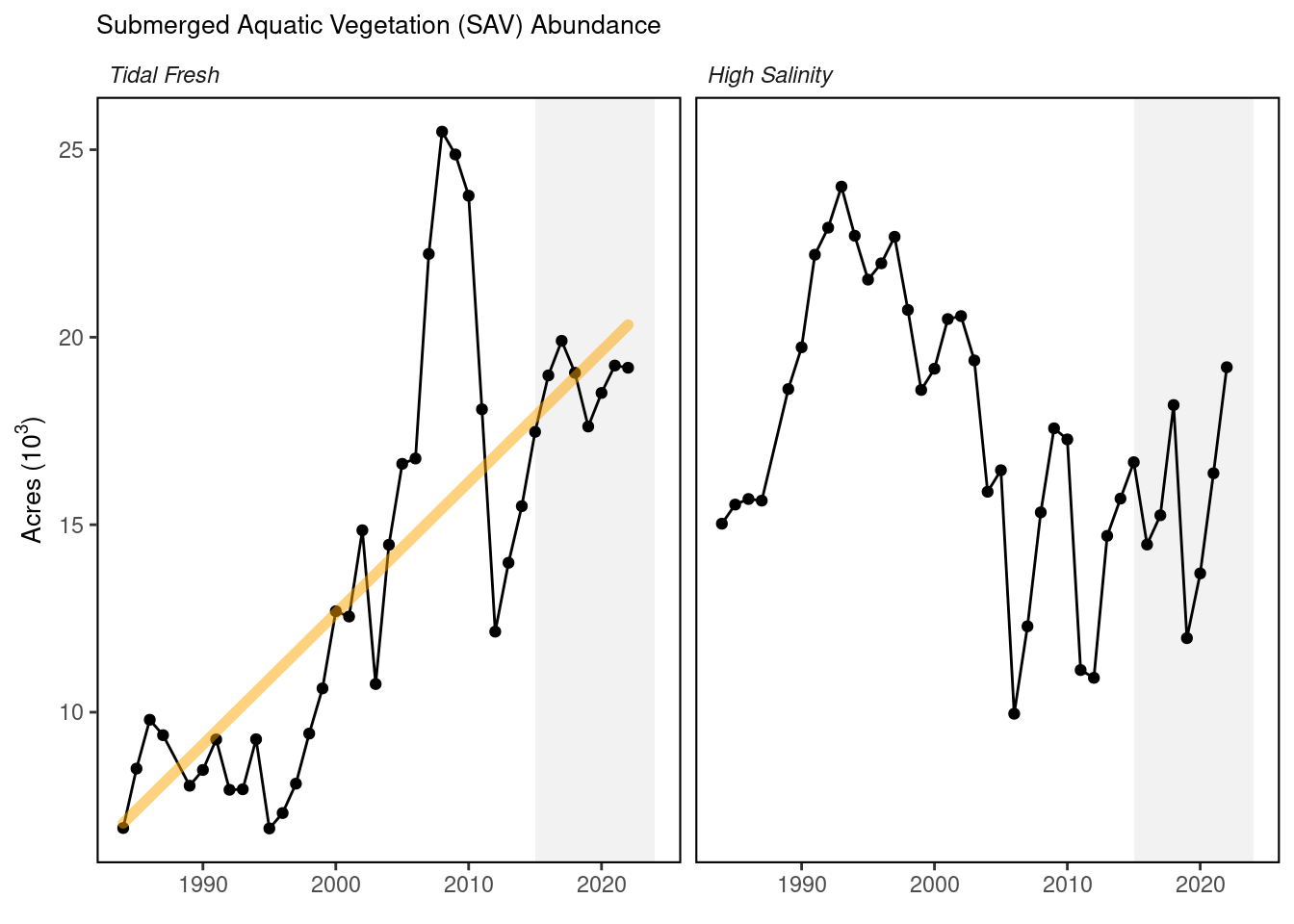4 Submerged Aquatic Vegetation
Description: The data provided here are the 1984-2023 area distribution and percent coverage of submerged aquatic vegetation in the Chesapeake Bay and its tributaries. That area is measured and calculated from photo-interpreted aerial imagery taken during surveys conducted in the growing season.
Indicator family:
Contributor(s): Christoper J. Patrick, David J. Wilcox, Jennifer R. Whiting, Anna K. Kenne, Erica R. Smith
Affiliations: VIMS
4.1 Introduction to Indicator
Underwater grass beds are critical to the Chesapeake Bay ecosystem. They provide food and shelter to fish and wildlife, sequester carbon, add oxygen to the water, absorb nutrient pollution, reduce shoreline erosion and help suspended particles of sediment settle to the bottom. Because they are sensitive to pollution but quick to respond to improvements in water quality, underwater grass abundance is a good indicator of the Bay’s health. Before Europeans colonized the region, up to 600,000 acres of underwater grasses may have grown along the shorelines of the Bay and its tributaries. By the mid-1980s, nutrient and sediment pollution had weakened or eliminated many of these grass beds. While climate change, shoreline hardening and stressors that reduce water clarity will continue to impact our restoration success, many of these stressors can be managed with on-the-ground efforts to reduce pollution and research has shown that nutrient reductions made under the Chesapeake Bay Total Maximum Daily Load (Bay TMDL) have played a critical role in the overall underwater grass recovery documented since the Bay-wide aerial survey began in 1984.
4.2 Key Results and Visualizations
The Mesohaline and Polyhaline zones saw significant increases in SAV, and there was also a modest increase in the Tidal Fresh zone. The Mesohaline zone increased by 21% relative to 2022 (2,665 hectares or 6,584 acres), mainly driven by the 1,048 hectare increase in the Tangier Sound segments. The Polyhaline zone increased 12% relative to 2022 (923 hectares or 2,281 acres), including a record 445 hectares from the Mobjack Bay segment and 404 hectares from the Eastern Lower Chesapeake Bay. This is the most SAV reported for the Polyhaline Zone since 1997 and the 4th consecutive increase in coverage in this zone. The Tidal Fresh zone had a 3% increase (159 hectares or 393 acres) while the Oligohaline zone showed a large 54% decrease (1,516 hectares or 3,746 acres), due to heavy losses in the middle Potomac and the Gunpowder River in Maryland on the west side of the Bay. The increases in the Mesohaline zone largely reflect recovery following the SAV crash in 2019. Those losses in 2019 were largely due to declines in widgeongrass which is prone to boom and bust cycles of expansion and retraction. For example, in 2018, the Mesohaline and northern Polyhaline salinity zones widgeongrass increased and eelgrass was observed by the survey for the first time in an extensive region east of Tangier Island, but these gains were reversed in 2019. The subsequent decline we observed in 2019 mirrors a similar rapid increase in widgeongrass in 2001 and 2002 that was followed by about a 50% decline in 2003. Gains in the Polyhaline are driven in part by recovery of widgeongrass following the 2019 crash but also by expansion of eelgrass into deeper waters, in some areas expanding beyond historically observed meadow boundaries.
4.3 Indicator statistics
Spatial scale: The data covers the tidal Chesapeake Bay region.
Temporal scale: 1984-2023, annual
Synthesis Theme:
4.4 Implications
- Bay-wide: In 2023, 82,937 acres of SAV were mapped in the Chesapeake Bay. This is 64% of the Bay SAV goal.
- Tidal Fresh Salinity Zone: 19,804 acres in 2023 achieving 96% of the area’s 20,602-acre goal.
- Oligohaline Salinity Zone: 3,429 acres in 2023 achieving 33% of the area’s 10,334-acre goal.
- Mesohaline Salinity Zone: 37,961 acres in 2023 achieving 32% of the area’s 120,306-acre goal.
- Polyhaline Salinity Zone: 21,743 acres in 2023 achieving 65% of the area’s 33,647-acre goal.
The outlook toward achieving the outcome goal is uncertain. Gains from 2022 to 2023 are positive, indicating an on-course trajectory, but these gains don’t yet offset the recent major declines observed in 2019. Additional years of positive trajectory will help clarify whether this recent gain in 2023 is the start of a new positive trend toward higher levels of SAV across the Bay.
4.5 Get the data
Point of contact: Christoper J. Patrick (cpatrick@vims.edu), David J. Wilcox (dwilcox@vims.edu)
ecodata name: ecodata::SAV
Variable definitions
- Name: Year; Definition: SAV growing season; year. 2) Name: Tidal Fresh Total; Definition: SAV area in the Tidal Fresh Zone; Units: acres. 3) Name: Oligohaline Total ; Definition: SAV area in the Oligohaline Zone; Units: acres. 4) Name: Mesohaline Total; Definition: SAV area in the Mesohaline Zone; Units: acres. 5) Name: Polyhaline Total; Definition: SAV area in the Polyhaline Zone; Units: acres. 5) Name: Baywide Total; Definition: Total SAV area in Chesapeake Bay; Units: acres.
Indicator Category:
4.7 Accessibility and Constraints
No response
tech-doc link https://noaa-edab.github.io/tech-doc/SAV.html
